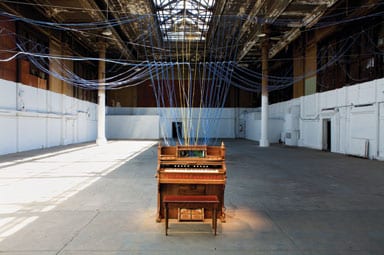
words Bill Millard
There’s a good case for viewing David Byrne as an artist first and a musician second. But his first major project after art school, Talking Heads – as much a conceptual-art experiment as a band – grew prominent enough to become something of a personal albatross. Speaking with Anne Pasternak, president of public art organisation Creative Time, he explained: “Early reactions to my visual work tended to be couched in ‘rock star makes art!’ terms, so any serious intent in the art got steamrolled by the baggage I carry.” It’s regrettable that this baggage overshadows some of his more thought-provoking art and writing; his ideas about contexts, genres, populism and urban mores are no gimmick.
Byrne’s latest work breaks the wall between his sonic and conceptual endeavours. It’s a low-key, common-sense intervention into public space, a deceptively humble instrument on which he doesn’t personally perform. Playing the Building, an 11-weekend installation in the Battery Maritime Building in lower Manhattan, adapts an out-of-tune pump organ as the switchboard for an array of circuits, solenoids, pneumatic compressors and other hardware connected to the pipes, girders, radiators and electrical conduits of a large unused room. The invitation PLEASE PLAY is spray-painted on the floor in front of the organ, and New Yorkers have been queuing up to make it clang and hum.
All sounds emanate from the building’s infrastructure; nothing is amplified, synthesised or prerecorded. Anyone who’s lived in a city or spent time around industrial structures recognises these noises, but Byrne’s instrument lets users give them rhythm and form. Most of the sounds triggered by higher keys are percussive; motors responding to certain left-hand keys supply a gritty baritone groan; the middle octaves produce flutelike tones from pipes with strategically drilled holes. The sounds’ pitches are not tuned to notes on the keyboard, and some keys are silent.
“A trained musician doesn’t have an advantage over anybody else,” says Byrne. “Nobody’s going to sit down and be a virtuoso.” At 835sq m, the room has cathedral-like acoustics, and everyone, including children, can produce impressive effects with the device. It immediately brings out the joyful little kid even in jaded, black-clad adult Manhattanites.
This is the second iteration of Playing the Building, after a 2005 version in a Stockholm factory. Two years of negotiations, aided by Creative Time, have overcome bureaucratic hurdles and brought it to a city that can always use more playfulness, not to mention more imaginative views of its own history. Lately New York has had trouble sustaining its own best ideas, but this installation is a refreshing reminder of how vanishing industrial spaces feel as well as sound. The Maritime Building, a Walker & Morris Beaux-Arts relic from the era of East River ferries, is a decrepitly elegant marvel of cast and wrought iron and a natural setting for the steampunkish instrument, its air tubes and wiring fanning out behind the organ in jerry-rigged exuberance. It will soon be a hotel and restaurant; one hopes the developers respect its uniqueness.
Byrne has inverted Goethe’s well-worn line defining architecture as frozen music: here, one makes music out of some long-frozen architecture. His device shifts the ratio of activity and passivity in people’s experience of everyday acoustics, much as graffiti lets citydwellers reclaim a little control over their surroundings from advertisers and propertied interests. “Yes, we’re bringing democracy to Lower Manhattan,” Byrne quipped at the press preview.
Scales can’t be played on this keyboard, but by conferring a little temporary power over modern space, it’s an ingenious effort at balancing the scales.
images Justin Ouellette
top image The cast-iron Maritime Building wired up to the organ

Higher notes trigger percussive noises, and middle octaves provoke whistles from holes drilled in pipes
















